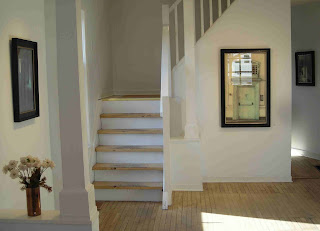“Trinary - A show of recent work by a trio of emerging artists” is the title of the current exhibition at the Cube Gallery. Presenting both abstract and figurative paintings, I was surprised by the broad spectrum of the works by
Kristy Gordon,
Susan Ukkola, and
M. (Peggy) Hughes. That's why I attended the Artists talk at the Cube Gallery on Sunday.
 |
| Kristy Gordon @ Cube Gallery |
I was in particular looking forward to meet the youngest of these artists,
Kristy Gordon. But unfortunately, she had no time to come to Ottawa from Toronto where she lives. This was such a pity, because I was so interested in her work! But her statement was shown in an uTube
video – and it already revealed what an energetic and enthusiastic artist she is.
 |
| Portraits and landscapes by Kristy Gordon |
Obviously, her paintings in oil refer to the
Pre-Raphaelites (founded in mid-19th century in England) with their soft landscapes, elegant compositions in an idealized nature setting.
 |
| Kristy Gordon |
But also her portraits are very impressive. As she mentioned in her uTube video, she first painted landscapes and later focused more and more on portraits of family and friends. She really catches the empathy between the artist and the sitter. Furthermore, a lot of her small scale paintings seem to sell very well: a lot of them are already marked with red dots! No wonder why she has received honours from the Portrait Society of America and e.g. made the third Prize at the Portrait Society of Canada International Portrait Competition.
 |
| Kristy Gordon: Study for self-portrait in Armour |
This is a study for a self-portrait in an Armour. Here, she clearly refers to the Quattrocento Italian painting. As she said, her interest in self-portraits comes from the fact that she understands them as a vehicle for self-introspection. Hope to see more!
 |
| Susan Ukkola's encaustic paintings @ Cube Gallery |
Susan Ukkola mentioned that she works intuitively, starting from a simple idea. Working in encaustic, she responds to the surface, adds and removes colour, until she likes the results. She emphasized on her love for the encaustic medium, because she loves the lines and scratches on the surface. Therefore she can combine her interest for drawing with her excitement for painting. Finally, when “it feels right” she creates marks on the surface, by scratching into it. Surprisingly, she even uses a meat tenderiser! With the last step, the patina, the texture becomes visible. “The line is what makes my paintings an artwork!”
 |
| Peggy Hughes |
Peggy Hughes works non-representative or abstract since 10 years now. She started in watercolour before she retired, but then switched to acrylic. In her talk, she referred to the visual texture of her abstract paintings and to her ongoing search for forms and shapes. She develops them from the textures.
 |
| Peggy Hughes in the Trinary exhibition |
Hughes focuses on three main topics: isolated forms, abstract shapes that remind us on cityscapes, and imaginary forms.
"Trinary" shows figurative and abstract works in oil, acrylic and encaustic – a broad spectrum of contemporary painting.
Facts:
Trinary - Kristy Gordon, Susan Ukkola, M. (Peggy) Hughes
Cube Gallery
March 1 – 27, 2011
Exhibition link


















